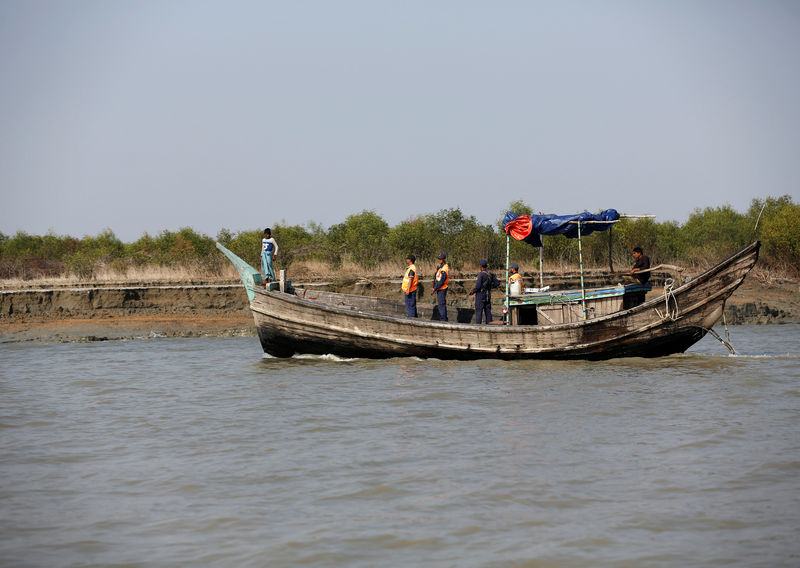By Antoni Slodkowski
THENGAR CHAR, Bangladesh (Reuters) - The island is two hours by boat from the nearest settlement. There are no buildings, mobile phone reception or people. During the monsoon it often floods and, when the seas are calm, pirates roam nearby waters hunting for fishermen to kidnap for ransom.
Welcome to Thengar Char, a muddy stain in the murky waters of the Bay of Bengal, identified by Bangladesh as a short-term solution to the humanitarian crisis unfolding on its border with Myanmar, across which some 70,000 Rohingya Muslims have fled.
Those refugees, escaping an army crackdown on insurgents that began in October, have joined more than 200,000 Rohingya already living in official and makeshift camps, straining resources in one of Asia's poorest regions. Bangladesh says the refugees bring crime and a risk of disease.
The influx has prompted Dhaka to revive a plan - much criticized by humanitarian workers when it was first proposed in 2015 - to move thousands of people to this uninhabited island about 250 km (150 miles) northwest of their border camps.
While most experts dismiss the scheme as impractical, a Bangladeshi minister told Reuters this week that it was determined to push ahead, adding authorities would provide shelters, other facilities and livestock.
Local administrators, however, say they have not been informed, and when Reuters visited the island the only signs of activity were a few buffalo lazily grazing on the yellow grass along its shores.
"We have only heard bad things about the Rohingya. If they work with the pirates and get involved in crime - we don't want them here," said Mizanur Rahman, 48, the administrator of Might Bangha village, the closest settlement to Thengar Char.
Rahman added, however, that if the Rohingya were "good people", they should be helped on humanitarian grounds. Others from the village echoed that sentiment, saying they were fellow Muslims and deserved assistance.
The crisis is the biggest challenge facing the government of Aung San Suu Kyi, straining Myanmar's relations with the countries of the region hosting large Rohingya populations such as Bangladesh and Malaysia, but also the United States.
About 1.1 million Rohingya live in apartheid-like conditions in northwestern Myanmar, where they are denied citizenship. Many in Buddhist-majority Myanmar regard them as illegal immigrants from Bangladesh, while the authorities in Dhaka say they are Myanmar nationals and must ultimately go back.
To view a graphic on Bangladesh's Rohingya relocation plan, click http://tmsnrt.rs/2k7ZAZy
PIRATES AND MACHINE GUNS
It takes about two hours by boat from Rahman's village on the coast of Sandwip - one of the largest islands in an archipelago in southern Bangladesh - to Thengar Char.
Reuters journalists were escorted there by a fishing boat and a coastguard vessel carrying seven officers equipped with Chinese-made machine guns to stave off potential pirate attacks.
Villagers complain criminals roam the nearby waters, seizing vessels, stealing the catch and releasing fishermen only after receiving a ransom.
Thengar Char is flat and featureless, covered by bushes, grass and windswept trees.
It emerged from the sea about 11 years ago, off Sandwip's western coast, one of the myriad of shifting, unstable islands formed by sediment in the mouth of the mighty Meghna river.
While Thengar Char looked calm on a sunny winter afternoon, the main objection voiced by aid agencies to Bangladesh's plan is the area's unforgiving climate.
"These areas are cyclone and flood-prone," said Quamrul Hassan, a meteorologist at the Bangladesh Weather Department, adding that the islands in the Bay of Bengal were "especially risky" to inhabit.
"Average rainfall during the monsoon season in the coastal areas is more than double that of the other parts of the country."
Many people living on the islands are regularly evacuated during the cyclone season to shelters built on the coast, said local journalist Saleh Noman.
He thought the relocation plan wasn't realistic.
"There is a similar island in the area and it took some 40 years for it to develop. Bet even now it's all very basic," said Noman.
There are currently around 30,000 Rohingya living in camps run by the United Nations near border with Myanmar, while tens of thousands more are crammed into slums that have grown up around them, without proper sanitation or healthcare.
The Rohingya from those settlements sometimes find employment, but most are sustained by local villagers and rations quietly distributed by international aid agencies.
"We can operate here, but we can't really talk about it," said one aid worker based in the border region.
Rohingya refugees Reuters spoke to did not want to stay where they were - but neither did they want to be moved to Thengar Char.
"We left everything in Myanmar," said Abu Salam from Kya Guang Taung, a village in northern Myanmar that was destroyed in the crackdown. He crossed the border in December.

"That's where our home is. If only we could get citizenship, we would like to go back."